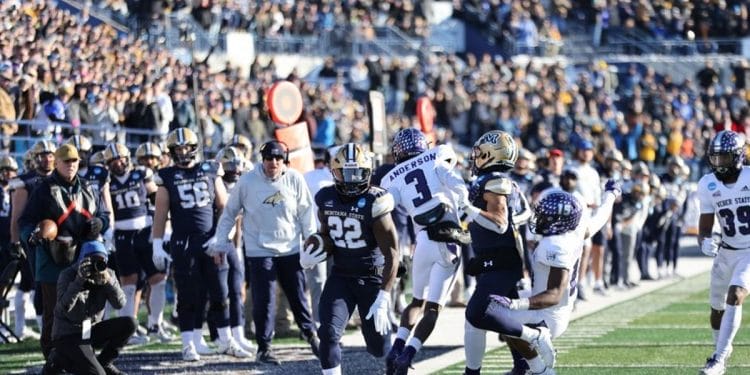No. 4 seed Montana State travels to No. 1 seed South Dakota State for a Saturday afternoon FCS semifinal matchup.
What does MSU need to do to reach another FCS title game? Here are five keys for a victory.
RELATED: 5 Keys For An SDSU Victory
Stretch SDSU’s Defense Sideline To Sideline
MSU is at its best when the ground game attacks the perimeter of a defense. Sean Chambers or Isaiah Ifanse runs up the middle can soften up a defense, but the offensive line is especially good at getting out in space and setting the edge on outside zone runs by Chambers, Ifanse, Elijah Elliott, or Tommy Mellott.
MSU leads the FCS in rushing offense (332.4 YPG). SDSU leads the FCS in rushing defense (85.2 YPG). The Jacks are strong up the middle. They have arguably the best FCS DT in Caleb Sanders, and the middle linebacker play has been stellar, strengthened by All-American Adam Bock returning from injury last week.
SDSU’s OLBs are good, and the safeties love to come down in a hurry to hit. But the defensive ends are bigger body types than speedy DEs, so MSU will likely have a lot of read-option looks, set the edge, and try and get its ball carriers beating angles from defenders for outside runs toward the sidelines.
Stout Defensive Line Play
SDSU is going to test the middle of MSU’s run defense. The Jacks have some maulers on the o-line, Isaiah Davis is a load to bring down, and Mark Gronowski has become dangerous with his legs again. The Bobcats have been strong against the run, led by DT Sebastian Valdez and MLB Callahan O’Reilly. They allow just 129.2 rushing YPG.
While Davis is good at bouncing to the outside and shedding tacklers on the perimeter, SDSU is going to first try and come downhill at you. The MSU defensive line needs to hold up strong.
RELATED: SDSU vs. Montana State Tale of the Tape
Tackle Isaiah Davis
This is football 101, of course. But Davis is good for at least one highlight-reel run per playoff game. He hits another level in the postseason, and his runs can energize SDSU’s offense and demoralize the opposing defense.
Davis has the ability to turn what looks like a negative or short gain into a long run. MSU’s defense needs to bottle him up, wrap up, rally to the football, and not allow him to stiff-arm would-be tacklers as he bounces outside and gains 20+ yards after first contact.
Secondary Steps Up
Compared to its 129.2 rushing YPG allowed, which is 32nd in the FCS, MSU allows 222.0 passing YPG, 61st in the subdivision. The Bobcats have been strong against the run all season, but have struggled against the pass in different games.
They allowed 324 passing yards against FBS Oregon State, 201 against Eastern Washington, 267 against Northern Colorado, and 459 against Northern Arizona. All of those games were on the road (Oregon State was a neutral site).
While those offenses are different stylistically than SDSU, the Jacks have as talented of a pass-catching group as anyone in the FCS. TE Tucker Kraft is 6-foot-5, 255 pounds, and will be an early NFL Draft pick this spring. TE Zach Heins will get a pro shot as well at 6-foot-7 and 260 pounds. He has 10 TD catches these last two seasons. Twin brother WRs Jaxon and Jadon Janke have a combination of size (6-foot-3, 210 pounds), speed, strength, and athleticism that translates to the next level.
MSU will first be tested on the ground, but the Jacks are just as dangerous throwing the ball, notably on play-action when the LBs and safeties are creeping up.
WRs Seize Opportunities To Make A Big Play
The Bobcats continue to have the most dominant run game in the FCS even when defenses know it’s coming. The challenge is even though you know a run is coming, you don’t know exactly how it’s coming. Is it a running back dive up the middle, or a read option, or QB power, or QB sweep, or what’s going to happen when two QBs line up next to each other, or one QB is lined up as a WR and goes in motion for an option look from the other QB?
MSU will run and run and run against SDSU. But against the top rushing defense in the FCS, plays will need to be made through the air at key points. The most dangerous triple-option teams are the ones with that one dude on the outside. While MSU obviously isn’t a triple-option team, Lance McCutcheon served as that dude in last year’s playoff run to win 50/50 balls on fade routes as the defense stacks the box.
McCutcheon is now in the NFL, but the Bobcats have a group of receivers who are still playmakers. Willie Patterson is a legit deep threat despite being 5-foot-9. And Ravi Alston is a former D3 All-American who can provide matchup problems at 6-foot-3.
Chambers may be the more polished passer, but Mellott can also deliver a beautiful ball into the bucket when there’s no safety help over the top and it’s just a CB on an island. Both are threats to pass. MSU will need them to be accurate when dialing up passing plays, and the WRs have to make plays when the opportunity comes.



